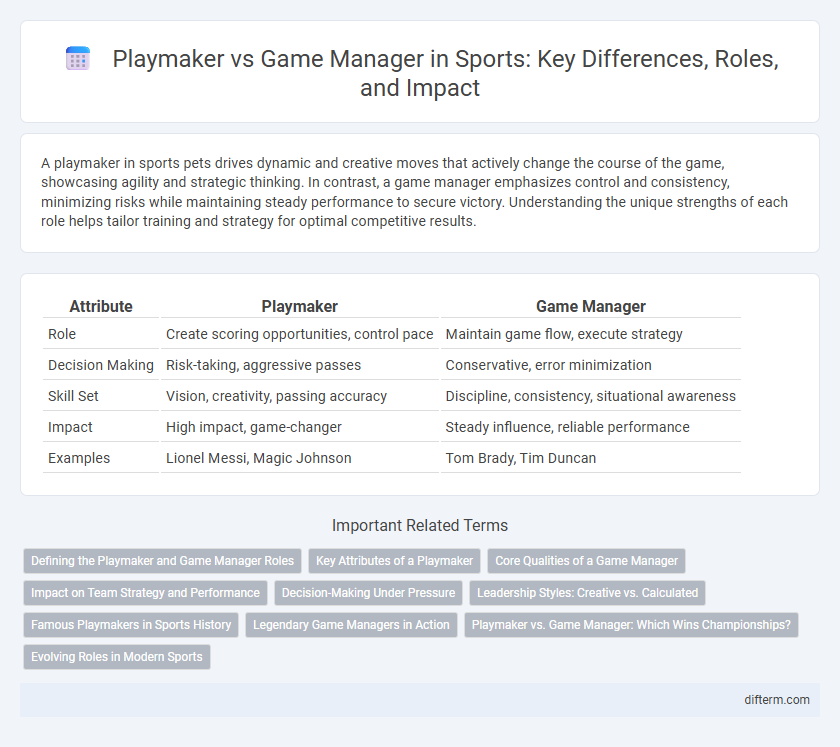A playmaker in sports pets drives dynamic and creative moves that actively change the course of the game, showcasing agility and strategic thinking. In contrast, a game manager emphasizes control and consistency, minimizing risks while maintaining steady performance to secure victory. Understanding the unique strengths of each role helps tailor training and strategy for optimal competitive results.
Table of Comparison
| Attribute | Playmaker | Game Manager |
|---|---|---|
| Role | Create scoring opportunities, control pace | Maintain game flow, execute strategy |
| Decision Making | Risk-taking, aggressive passes | Conservative, error minimization |
| Skill Set | Vision, creativity, passing accuracy | Discipline, consistency, situational awareness |
| Impact | High impact, game-changer | Steady influence, reliable performance |
| Examples | Lionel Messi, Magic Johnson | Tom Brady, Tim Duncan |
Defining the Playmaker and Game Manager Roles
The playmaker in sports is characterized by creativity, vision, and the ability to orchestrate offensive plays, often acting as the team's primary source of scoring opportunities and dynamic passes. In contrast, a game manager emphasizes control, efficiency, and minimizing mistakes, focusing on maintaining possession, executing fundamental skills, and making strategic decisions that sustain team stability. Both roles are crucial but cater to different aspects of gameplay, with the playmaker driving innovation and the game manager ensuring consistent performance.
Key Attributes of a Playmaker
Key attributes of a playmaker include exceptional vision, precise passing, and the ability to read the game, enabling them to create scoring opportunities and control the tempo. Playmakers exhibit creativity and quick decision-making skills, often unlocking defenses with their unpredictable movements and strategic positioning. Their leadership on the field drives their team's offensive dynamics, distinguishing them from game managers who primarily focus on minimizing mistakes and maintaining possession.
Core Qualities of a Game Manager
Game managers excel in decision-making, maintaining control, and minimizing risks during the game, prioritizing strategic plays over flashy moves. Their core qualities include exceptional situational awareness, consistent performance under pressure, and effective communication with teammates. These attributes enable game managers to orchestrate the flow of the game, ensuring stability and maximizing team efficiency.
Impact on Team Strategy and Performance
A playmaker drives offensive creativity by orchestrating scoring opportunities and adapting tactics on the fly, significantly enhancing a team's dynamic attack and unpredictability. In contrast, a game manager emphasizes control and consistency, minimizing errors while maintaining possession to execute a predefined strategy effectively. Teams relying on playmakers tend to excel in fast-paced, adaptive environments, whereas those with game managers prioritize stability and disciplined execution to secure victories.
Decision-Making Under Pressure
Playmakers exhibit rapid, creative decision-making under pressure, often improvising to exploit weaknesses in the opposition's defense. Game managers prioritize consistent, risk-averse choices that maintain possession and control the game's tempo, minimizing costly errors. Both roles require acute situational awareness but differ in their approach to pressure-induced decision-making in competitive sports.
Leadership Styles: Creative vs. Calculated
Playmakers exhibit a creative leadership style, driving innovation with unpredictable plays that inspire and energize teammates. In contrast, game managers adopt a calculated leadership approach, emphasizing strategic decision-making and risk minimization to maintain control and consistency. Both styles significantly impact team dynamics by balancing spontaneity with discipline on the field.
Famous Playmakers in Sports History
Famous playmakers such as Diego Maradona in soccer, Magic Johnson in basketball, and Tom Brady in American football have redefined their sports with exceptional vision and creativity, orchestrating offensive strategies that elevate team performance. These athletes demonstrate unparalleled skill in anticipating opponents' moves and delivering precise passes or plays that create scoring opportunities. Their ability to control the tempo of the game and make split-second decisions distinguishes playmakers from game managers, who typically focus on maintaining consistency and following established game plans.
Legendary Game Managers in Action
Legendary game managers like Bill Belichick and Nick Saban exemplify strategic control and situational mastery, orchestrating team dynamics with precision rather than relying solely on individual brilliance. Their emphasis on disciplined execution and adaptive play-calling has consistently led to championships, showcasing the critical role of game management in winning sports. These coaches demonstrate that managing the flow of the game often outperforms the unpredictability of a traditional playmaker in high-stakes scenarios.
Playmaker vs. Game Manager: Which Wins Championships?
Playmakers, known for their creativity and ability to control game flow, often drive high-impact plays that can change the course of a championship. Game managers excel in decision-making, minimizing mistakes, and maintaining consistency under pressure, crucial traits for playoff success. Championship-winning teams frequently blend both roles, valuing a playmaker's dynamic influence alongside a game manager's steady leadership.
Evolving Roles in Modern Sports
Playmakers drive offensive strategy by creating scoring opportunities through vision and creativity, while game managers focus on controlling tempo and minimizing mistakes to maintain team stability. In modern sports, the evolving roles blend these qualities, with players expected to balance dynamic playmaking skills and disciplined decision-making. This hybrid approach enhances team adaptability and overall performance in high-pressure scenarios.
playmaker vs game manager Infographic

 difterm.com
difterm.com